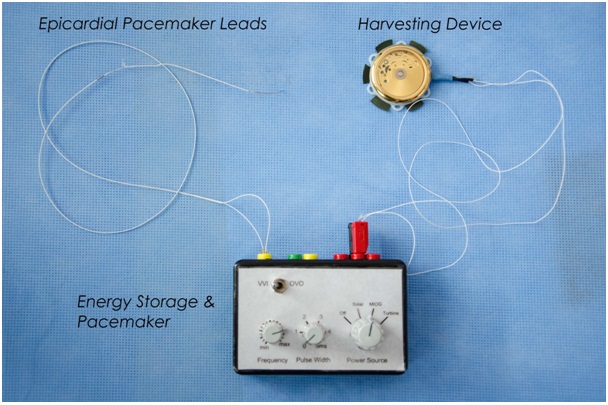Chinese scientists have developed a piezoelectric generator for pacemaker

The other day, a group of specialists from China published the results of their work on the creation of a piezoelectric generator for a pacemaker. The developers have already tested the pig, which implanted such a generator, previously connected to a pacemaker with batteries removed.
Stimulator - a device that provides heart contraction in a certain mode. It generates electrical impulses, which cause the heart to contract, already unable to work without support.
Usually, stimulants are implanted in the patient’s chest cavity, and the gadget works from batteries, which last for several years. After the charge is over, the patient has to undergo an operation, during which either the battery or the entire stimulator is changed.
Now there are other developments - for example, pacemakers, which do not need batteries, they receive current from generators. One of the best generators is the heart itself, whose muscles are constantly moving.
Chinese scientists led by Hao Zhang of the Second Military Medical University of China successfully tested. In its course, the implanted piezoelectric generator was able to power the pacemaker inside a living organism. The generator has a size of about three centimeters.
The frame of the device is made of polyethylene terephthalate. The shape of the stimulator, when viewed from the side, resembles the figure 8. The body material is elastic, so the generator can both shrink and return to its previous shape. On both sides of the system, scientists placed composite piezoelectric strips, which consist of lead-based compounds. The strips are surrounded by films of chromium and gold, playing the role of electrodes.
The principle of operation of the generator is the generation of electricity during deformation. Actually, this is how many piezoelectric generators work. The development of Chinese scientists produces electricity both during compression and when returning to normal.

First, scientists created a prototype, then a system that can work without any problems in the laboratory. The final stage, which was already mentioned above, is the placement of the system inside a living organism, in this case, the pig.
The laboratory tested a very simplified prototype, consisting of a container of water with a generator inside. A piston with a compressible polymer tip presses on the generator. This whole system models tissue on the outer surface of the heart.
When it turned out that the system was working, scientists conducted a series of experiments that showed that if you add another piezoelectric layer and connect them in a parallel circuit, then the power increases by more than two times, reaching an indicator of 33 microwatts.

In the experiments, it was decided to use a Yorkshire pig. A generator was mounted on the animal’s heart, connecting it to a current rectifier. And then the whole system was connected to a pacemaker with a battery removed. During operation, the device is configured at about 80 cuts per minute. The heart of the pig worked in the same rhythm, supported by a stimulant with a supplied current. Prior to the experiment, the shock frequency was 60-70 per second.
After the experiment, scientists checked the readings of the electrocardiogram, which allowed us to talk about successful experience.
By the way, devices of this type were created before. Back in 2014, a scientist named Tsurbushen developeda pacemaker operating on the principle of a car factory of a conventional mechanical wristwatch. The prototype was created in a few weeks and after checking its work, it turned out that the idea was quite working. Moreover, contractions of the heart muscle are also a tool for generating energy. The heart sets in motion the mechanism of the pacemaker, causing the acting elements to rotate. Rotation, in turn, compresses the mechanism spring, which is reduced to a certain limit. Next, the spring unwinds, making a small electricity generator work.

It, in turn, accumulates in the battery and is used to maintain the pacemaker system, which leads to correction of the rhythm of contraction of the heart muscle.
